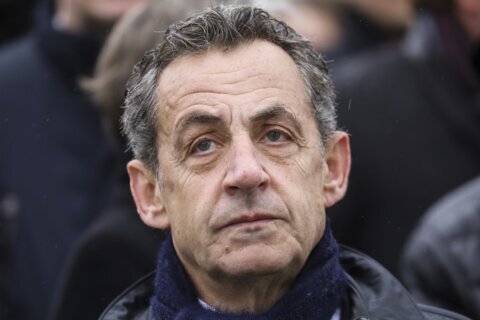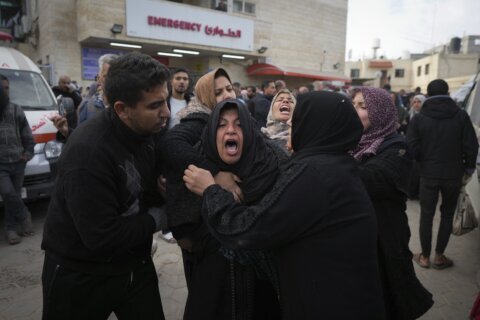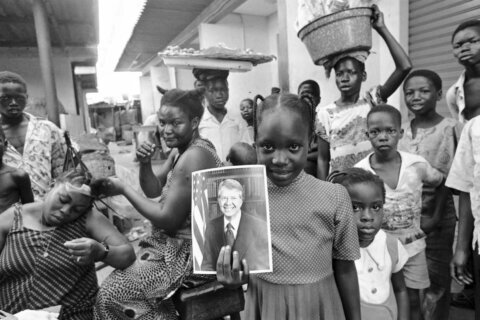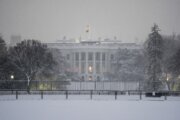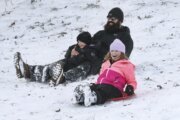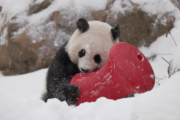ERIC TALMADGE
Associated Press
LAKE CHON, North Korea (AP) — The Kaema Plateau, the “Roof of Korea,” is a stunning, forest-covered highland nestled in such treacherous mountains that it was never taken by the Allies during the Korean War. It’s now a truck stop.
As we squatted beside our lunches of kimchi and cold rice, in the distance, almost hidden in the thick mist, a woman sold refreshments in a tarp-covered stall. A half-dozen older people put down their loads and sat on a weed-covered embankment nearby; they had arrived on foot, even though the nearest town was hours away. One member of the group, a leathery man, rolled a cigarette and drew the smoke in deeply.
It’s quite possible none of them had ever seen an American before. But our presence went unacknowledged. No glances were exchanged. No words were spoken.
We had been granted unprecedented access to see North Korea and travel through places that, we were told, no foreign journalists and few foreigners had been allowed to see before. We would drive 2,150 kilometers (1,336 miles) in a country that has barely 25,000 kilometers of road, and only 724 kilometers of those paved. By the time we returned to the capital a week later, our Chinese-made Great Wall SUV had a few new scratches and one less hubcap.
But this trip was on North Korea’s terms. There would be no stopping to interview random people like the ones at Kaema.
Even on the loneliest of lonely highways, we would never be without a “minder,” whose job was to monitor and supervise our activities. We were not to take photographs of any checkpoints or military installations. For the most part, we were not to detour from our pre-approved route, which, to no one’s surprise, didn’t include nuclear facilities or prison camps.
We finished our meal in silence and drove on.
Though we would not get to know the people along the way, the country itself had a great deal to say. And it was opening up before us.
___
We set off from a luxury hotel in Pyongyang. Before leaving the capital, we stocked up on supplies at a supermarket that sells everything from Evian to Skippy peanut butter. We also bought $100 worth of coupons good for 65 kilograms of diesel fuel — that’s how it’s sold in North Korea. A big red sign at the gas station proclaimed the site a “battleground” in the nation’s socialist revolution.
Razed to the ground in a scorched earth policy by the U.S. military during the Korean War, then rebuilt almost entirely from scratch with help from the Soviet Union, the North’s capital is intended to awe. By many measures, and certainly by developing world standards, Pyongyang, with its pastel-colored high rises, its towering monuments and its orderly, litter-free avenues, is an impressive metropolis. And to the nine-tenths of North Korea’s 25 million people who don’t live there, it is probably as alien as the Emerald City was to Dorothy.
As we made our way out of town down Reunification Avenue, we checked our Instagram feeds and Whatsapp chats with friends in the outside world, and gazed out at sharply dressed Pyongyang women clutching their domestically assembled Arirang smartphones, which aren’t connected to the Web and can’t make, or receive, international calls. Even in the capital, North Korea remains, to virtually all of its inhabitants, a country that has yet to enter the Internet age.
After about 20 minutes, we, too, would be off the grid.
___
Two hundred kilometers of the country’s best road is the stretch of highway connecting the capital, which is in the west, to the east coast port city of Wonsan. It’s paved all the way. Beyond Wonsan, potholes, cracks, sudden patches of dirt road or, worse yet, partially paved dirt road make travel a joltingly bumpy experience.
To get out of Pyongyang, we weaved our way around buses, streetcars, the black sedans of party officials and fleets of colorful new taxis that have over the past few years become commonplace.
Outside the city limits, bulky, exhaust-belching trucks made in China with rounded hoods reminiscent of the 1950s rule the roads. Passenger cars — and more importantly, our attention-getting Pyongyang license plates — were so rare that when we passed police or soldiers, they assumed we were important officials and saluted.
But vehicles of any kind are relatively few to begin with. Most of the action happens on the shoulder.
Even on the most rugged stretches of road, lone pedestrians laden with belongings or wares for the market stoically plod to the next village, which could be half a day away. The number of bicycles, along with long-distance buses, has skyrocketed in recent years. Ox carts and cobbled-together contraptions with lawnmower-sized engines outnumber the aging trucks. And those trucks? They often end up on the side of the road, too, the driver’s head buried under the hood while passengers sprawl out in the nearest patch of shade.
Through the windshield, we observed a landscape that appeared somehow preindustrial.
Villagers washed their clothes in rivers while barefoot children splashed and played. Old folks, in no hurry to be anywhere else, socialized under trees. And while the fashion set in Pyongyang obsesses over where to find the latest high heels, the countryside maintains a classically utilitarian look. The olive green work suit. The reliable rubber boot.
___
Blink-and-you-miss-them villages flew by as we headed north from Wonsan to Hamhung, North Korea’s second-largest city.
This is the traditional Korea: small, walled-off clusters of old but neat one-story houses, white with blue trim under clay roof tiles. Some were rigged with makeshift wire antennas, suggesting TVs inside. Others had single solar panels attached to their roofs. We would see more of those later, on the balconies of apartments in the larger provincial cities.
Most of North Korea’s villages — and cities, for that matter — are built around a central plaza or giant mosaics of the country’s founder, Kim Il Sung, and his son, Kim Jong Il. Their portraits hang in every home, and are worn over every adult citizen’s heart.
We could only wonder what the people in those homes might have to say to us. But we were barraged by what the government has to say to them:
“We Are A Great Spacefaring Nation!” ”Our Country Is The Best!” ”Let’s Go Our Own Way.” And the most common slogan, “Single-Minded Unity.”
The slogans are written in bright red on posters, murals and banners, or chiseled in stone. In field after field, posters of workers with their fists raised to the air declare the importance of the nation’s struggle, the quotas to be met and the valor of the model citizens who have fulfilled them.
“Congratulations to Chong Yong Il, head of work unit 1, for taking the lead in weeding our fields,” said one. Above the words was a painting of the Chollima, a mythical winged horse often used to symbolize the North’s many “speed campaigns.”
The inescapable voice of the ruling Workers’ Party is part pep talk, part reminder of who is in charge, part sermon on how the nation must strive and sacrifice to achieve the goals of “Kimilsungism” and “Kimjongilism,” which long ago supplanted Marxism and Leninism.
Inward-looking as it is, North Korea still likes to tout its special brand of socialism abroad. But the kind of internationalism embodied in such slogans as “Workers of the Word Unite” seems today to be, at best, an afterthought.
Only in the deepest mountains did the red-letter roar grow dim.
___
About four-fifths of North Korea’s land is too rugged to farm. But not for lack of trying.
Reflecting its preoccupation with agricultural self-sufficiency, every valley and flatland we passed seemed to be utilized for some sort of crop.
The countryside bursts with the bright greens of rice, corn, soybeans and cabbage. On hillier ground lie orchards for apples and pears. Up in the mountains, it’s potatoes. Whole villages are devoted to growing mushrooms, a “magic bullet” innovation from the 1990s when the country faced a near-cataclysmic famine.
Those desperate days appear to be long over. This year, according to United Nations experts, the North could come closer to feeding itself than it has in decades. But poor nutrition remains a serious problem. The World Food Programme says a third of North Korean children are stunted. Of the thousands of people we saw on our weeklong trip, only two were clearly overweight.
The wounds of famine-inspired policies fester in other ways.
Hillsides were stripped of trees to allow farming, though the plots produce little and increase the risk of erosion and landslides. Grass and shrubs might help keep the slopes intact, but then there are the goats: They are everywhere, thanks to Kim Jong Il’s mass goat-breeding campaign of 1996.
The landscape is filled with reminders of not only the desperate 1990s, but the booming 1960s, when North Korea was among Asia’s most highly industrialized nations.
The once-productive cities along its east coast, like the coal mining town of Kilju and the nearby city of Kimchaek — built around a sprawling but now eerily quiet ironworks complex — have become a rust belt, gritty and relentlessly gray.
Throughout our journey, we saw “shock brigades” — some soldiers but mostly regular citizens — mobilized to build levies along rivers, shovel dirt into potholes and repair retaining walls along hillsides. It’s backbreaking work, done mostly by hand. Still, every year, the country faces a cycle of flooding followed by drought.
Tourists experience only a bare trace of the deprivation residents feel.
At the best hotels in cities such as Hamhung, Samjiyon and Chongjin, the places where we stayed as our journey proceeded through the hinterlands, the rooms, replete with doilies and cushy velvet-covered chairs, were clean, the decor retro Soviet and the food plentiful. But the vintage TVs, when they worked, offered only one channel.
Standing by the window after my third night under a cold shower, in an overheated room with no thermostat, I looked out past a cabbage patch at the glow of candles and the beams of flashlights dancing in apartments across the street, where the power was out.
An hour later, at midnight, the lights were shining brightly from nearly every room. I wondered if people had forgotten to turn them off before they lost their electricity, or if, despite the hour, they were taking advantage of the light while they had it.
___
Despite all its firewalls, North Korea has never truly been a hermit kingdom. It has depended in turn on the largesse of the Soviets or Chinese, and has deftly extracted aid from what it sees as its own “axis of evil” — the United States, Japan and South Korea. Even so, when the North opens its doors, it does so for a reason.
It is now pursuing a plan to create dozens of special foreign investment and tourism zones. The highlight of our road trip, majestic Mount Paektu, with its crystal-blue crater lake, is one of the places the North most wants to promote. That’s probably why we were allowed to make the journey.
Along with its natural beauty, Paektu is considered the home of the North Korean revolution, dotted by reconstructions of “secret camps,” where guides dressed in period costume recount the legends of Kim Il Sung’s battles against the Japanese imperialists.
Though Paektu is central to North Korea’s identity, much of the mountain is in China. Before we left Pyongyang we were warned, half-jokingly, not to get lost.
“If you wander off into China,” we were told, “you will be shot.”
Something similar had, in fact, happened many years ago. No borders were involved, but a South Korean housewife who strayed off the accepted path at a tourist site was fatally shot in the back by a North Korean guard.
___
Wrested out of our beds for our ascent up to the summit, we fumbled without lights to pack our equipment, made our way down a candlelit staircase and climbed into our car in the pouring-down rain. With no signs to guide him, our driver steered silently into the night.
Many people have been amazed by nighttime satellite images that show North Korea as dark as the ocean, set against a northeast Asia brimming with light. There is nothing quite like experiencing that darkness on the ground over long stretches of the North Korean back country. Possibly more than any other populated place on the globe, North Korea is terra incognita.
As we drove toward the dawn, two armed soldiers in camouflage ponchos emerged from the darkness, signaled for us to stop and for our minder to get out. The rain was coming down harder as they stood in the blurry pool of our headlights.
One peered in at us through the rain-dotted window. There was a good deal of gesticulating. Then some head nodding. Our minder got back in the car.
We had gotten lost, but we weren’t in China. We were going the wrong way down a one-lane, one-way road.
The soldiers waved us on. With North Korean tourism still in its infancy, we were safe. We wouldn’t see another car until we reached the snowy, wind-whipped parking lot below the crater, where two small vans full of shivering Chinese waited for a guard to wake up and lead them to Lake Chon.
___
Follow Talmadge on Twitter at twitter.com/EricTalmadge and Instagram @erictalmadge
Copyright 2014 The Associated Press. All rights reserved. This material may not be published, broadcast, rewritten or redistributed.

